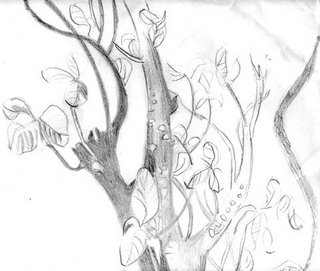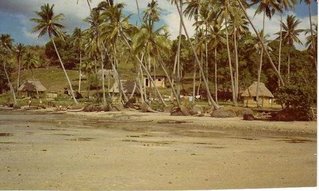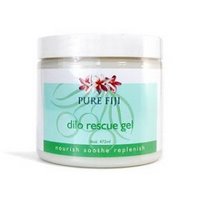

from w
If only a massage with Dilo magical cream would cool the fevered brow of a few all-over-the-place guys in Suva!
When we lived beside the sea at Nukutatava not far from Labasa, there was a medicinal tree called Dilo growing near the shore. I wonder if it is still there. Other names are Calophyllum inophyllum, Clusiaceae or Alexandrian laurel. It is a low branching tree from India and the Western Pacific and grows in many islands throughout Polynesia. The Dilo tree draws its sustenance directly from nutrient rich warm waters of the ocean.

The tree grows up to 25 or even 30 metres in height, with long, spreading limbs. The tree trunk is typically thick, with dark, cracked bark. The branches are covered with shiny, dark-green oval leaves and small white flowers with yellow centres. The blossoms give off a sweet perfume.
 The fruit of the tree, about the size of an apricot, has a thin flesh and a large nut hull inside. The somewhat poisonous kernel of the fruit yields "dilo oil," a thick, dark-green substance used medicinally and for lights. . The extract of the Dilo nut is believed to possess a unique capacity to enhance the skin's own repair mechanism, thereby accelerating the healing of wounds to the skin.
The fruit of the tree, about the size of an apricot, has a thin flesh and a large nut hull inside. The somewhat poisonous kernel of the fruit yields "dilo oil," a thick, dark-green substance used medicinally and for lights. . The extract of the Dilo nut is believed to possess a unique capacity to enhance the skin's own repair mechanism, thereby accelerating the healing of wounds to the skin. The reddish-brown timber is hard and straight, thus valued for making boat masts. It is also made into planks.. Because the timber does not smell or taste bad, it was also carved into food containers. The thick, dark green oil which exudes from the drying seeds was used as lamp fuel and to waterproof cloth ... The fruits are also used to make a brown dye. If the trunk is cut, it exudes a gum which solidifies. The fragrant flowers are used in leis. Traditional medicinal uses: The gum, bark, leaves, roots, flowers and the oil extracted from the seeds are used in traditional medicine for a wide range of ills. The oil is used for massages, together with coconut oil and flower fragrances. Reference:
 In Fiji a Dilo Gel is produced and sold as a skin lotion, especially for sunburn or dry skin or insect bites. It has a buttery texture and replenishes dry and damaged skin.
In Fiji a Dilo Gel is produced and sold as a skin lotion, especially for sunburn or dry skin or insect bites. It has a buttery texture and replenishes dry and damaged skin. More information about the dilo tree can be found on this website

10 comments:
Heh.
This reminds me of a story told to me by Anne Walker when we met her a couple of years ago in Melbourne.
During her time in the US, she developed a white patch on one of her arms. She knew that the only thing that could fix it was dilo, and she didn't want to go to the doctor because he would just give her some useless pills, but she couldn't get any dilo.
At one of her colleague's insistence, she ended up going to the doctor, who proceeded to tell her, "well, the only thing that will fix this will be an ointment made from the fruit of a tree that is found in the South Pacific."
He gave her dilo ointment! :-)
What a beaut story! Yes, that white patchy thing - maybe fungal. I had it on my arms one time and I dabbed it with kerosene.
Is Anne back in Melbourne for good? She did great work for many years - in New York I think it was, after her stint in Fiji setting up the YWCA. Those were very creative years, without the shenanigans that goes on these days - the army guy is going to be sworn in as Interim Prime Minister today!
W.
W,
is this cream available in Oz? Where in Melb?
Vinaka!
I don't know but I guess it would be in some of the health kind of shops. And of course in Fiji. I didn't post about it because I am into selling it! I am just interested in Fiji's medicinal trees and plants such as kura and dilo.
W.
Thanks for this most interesting post, W. I think that tree is called "kamani" in Hawaiian. Didn't know of it in Fiji.
That's a great story NZM.
Panda,
Yes, that's the same tree. It's apparently in many parts of Polynesia. I think it's sometimes called 'the Tree of a Thousand Virtues' or something like that.
W.
Tamanu or Dilo. The oil from this tree is a wonderful product and available from a guy called John Barrett who spends his time between Rotuma and Suva in Fiji. Pure Fiji uses Dilo in some of their skin care products and Sigatoka Spa uses it as a carrier oil for most of their massage therapies.
Wendy fantastic! I am back in Fiji and doing a bit of research on local plants for a degree back in NZ I should have known your blog would be the authority for anything I needed to know Fijian. Hope this finds you well :-)
Are there still Dilo trees in Fiji? Particularly the island of Wakaya?
This can cure coronavirus as well..
Post a Comment